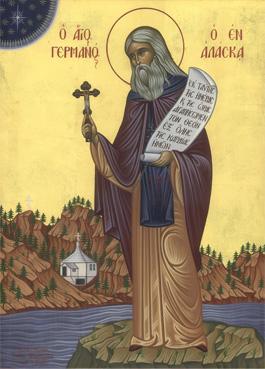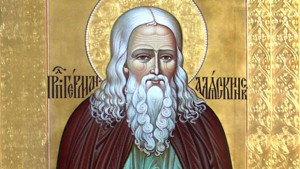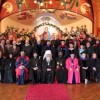 In an obscure corner of what is now Alaska, on an Aleutian island called Spruce, a monk labored from the late 1700’s until his repose in 1837. Braving subzero temperatures, plagues and storms, ill treatment from fellow Russians who resented and misunderstood him, St. Herman lived a life marked by astonishing ascetic labor that gave birth to a deep love and concern for all with whom he came in contact. Strangely, despite the miracles associated with him not only throughout his life but also, after his death, he was all but forgotten after he reposed.
In an obscure corner of what is now Alaska, on an Aleutian island called Spruce, a monk labored from the late 1700’s until his repose in 1837. Braving subzero temperatures, plagues and storms, ill treatment from fellow Russians who resented and misunderstood him, St. Herman lived a life marked by astonishing ascetic labor that gave birth to a deep love and concern for all with whom he came in contact. Strangely, despite the miracles associated with him not only throughout his life but also, after his death, he was all but forgotten after he reposed.
“Thirty years will pass after my death, all those who live now on Spruce Island will be dead, you alone will remain alive, and you will be old and poor; then they will remember me,” Father Herman said to his Aleut follower, Ignatius Aliaga. As with other prophecies of the saint, this one too was fulfilled, as in 1867, Bishop Peter of Alaska began a formal investigation into his life. It wasn’t until 1894 that his story became known to the outside world, and then his glorification waited another 76 years, until August 9, 1970.
Born into a merchant family in the diocese of Moscow, St. Herman became a monk when he was still a teenager, first entering the Holy Trinity Sergius Hermitage near Petersburg, then later moving on to venerable Valaam Monastery. The saint grew to love Valaam with his entire being; monks there remembered him singing at the cliros in a pleasant tenor voice, while tears streamed from his eyes. For the rest of his life, St. Herman considered Valaam his spiritual home; indeed, he called his hermitage on Spruce Island “New Valaam.” In a letter to Abbot Nazarius, he once wrote, “Your paternal kindness to my lowliness will not be erased from my heart, neither the terrible impenetrable Siberian wilds, nor its dark forests, nor will the great rivers wash away the memory; neither will rough seas extinguish these feelings. For in my mind I imagine my beloved Valaam and look always at it across the great ocean.”
In the second half of the 1700s, explorers were expanding the boundaries of Russia, and Metropolitan Gabriel asked Valaam’s Elder Nazarius to choose ten men to evangelize the Aleutians. Sadly, after five successful years of founding schools and churches, the head of the mission, Archimandrite Ioasaph, and his entire entourage drowned. One after another, others working on the mission left, until St. Herman remained alone.
One time, St. Herman was asked, “How do you, Father Herman, manage to live alone in the forest, don’t you get bored?” He answered “No, I’m not alone there! There is God, and God is everywhere! There are holy angels! How can one be bored with them? With whom is it more pleasant and better to converse, angels or people? Angels, of course!”
In addition to conversing with the angels throughout his hours of prayer and worship, St. Herman worked tirelessly. He ate and slept very little and when he slept, he used a bed that was a board and rested his head on a pillow of bricks. All his life, he wore the same simple clothing—a sleeveless deerskin shirt, his cassock and monk’s hat, a faded, patched mantle, and his shoes. In rain and storms, in the midst of winter snow or severe frost, he never changed his garments or added layers for warmth. His physical feats astonished those who knew him; one disciple saw him walking barefoot on a winter’s night, hauling a log that would have been difficult for four men to carry. With his own hands he built his cell and chapel, hauled baskets of kelp from the ocean to fertilize his garden, and in the midst of the labor meticulously kept the monk’s rule of services and prayers.
Tending his own garden and diligently observing his monastic rule didn’t keep St. Herman from reaching out with great love and concern to his Aleutian neighbors. On feast days and Sundays, he would gather them in the chapel next to his cell, and lead them in holy services; the people loved to listen to his spiritual teaching, and would visit him at all hours of the day and night, staying until early morning to absorb his instruction. The local Russian governor Yanovsky recalled, “To my amazement he spoke so powerfully, so sensibly, and argued so convincingly that it now seems to me that no education or earthly wisdom could withstand his words. We conversed every day until midnight, and even later, about the love of God, about eternity, about the salvation of the soul, and about Christian life. His sweet speech poured forth from his lips in an unceasing stream.”
St. Herman especially loved the Aleutian children, for whom he would bake cookies, and he watched over those who were weak and powerless. He started a school for orphans, tended the sick during a plague that decimated the population, and defended the native Aleuts before the Russian fur traders who were exploiting them. The people began to tell each other of miracles they’d seen. Fr. Herman would tell someone of a future event and it would come to pass; animals, even bears, would eat from his hands; he placed an icon of the Mother of God in the sand and a tidal wave receded back into the ocean.
People flocked to the elder for counsel and help. Affectionately, the Aleuts began to call him their “North Star,” referring to how his teaching guided and grounded them, or the even more intimate “Apa,” which meant grandfather. Couples with troubled marriages would seek his advice. With meekness, he would reproach people for their lack of sobriety or their cruelty. He himself for years refused any titles of elevation within the church, preferring the simplest designation, “monk.” His letters reflect his simplicity and tender disposition. “Our sins,” he wrote, “do not in the least hinder our Christianity… Sin, to one who loves God, is nothing other than an arrow from the enemy in battle. The vain desires of this world separate us from our homeland; love of them and habit clothe our soul as if in a hideous garment. We who travel on the journey of this life and call on God to help us, ought to divest ourselves of this garment and clothe ourselves in new desires, in a new love of the age to come, and thereby receive knowledge of how near or how far we are from our heavenly homeland.”
As the time of St. Herman’s repose drew closer, he began to tell his disciples to prepare, giving them specific instructions about his burial and services. Everything he prophesied related to his death came to pass, exactly as he had foretold, and so it was that on December 13, 1837, he leaned his head on the chest of his disciple Gerasim and reposed. “Glory to Thee, O Lord,” he pronounced with shining face, just before taking his last breath. In various Aleutian towns, people reported seeing a pillar of light, reaching from Spruce Island to the heavens. “St. Herman has left us,” one villager reportedly said.
Fortunately for the Aleuts and all Alaskans, St. Herman hasn’t ever left them. Miracles attributed to his intercessions have happened since his repose and are still happening today. Most Native Alaskans today are still Orthodox, and they honor his memory with prayers and pilgrimages. His relics rest in the Resurrection Church on Kodiak, and Orthodox faithful from all over the world come to venerate them and ask for his prayers.
















